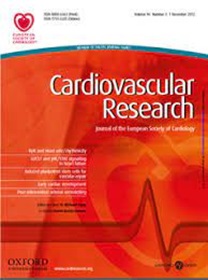Integrated proteomics identifies troponin I isoform switch as a regulator of a sarcomere-metabolism axis during cardiac regeneration
IF 10.2
1区 医学
Q1 CARDIAC & CARDIOVASCULAR SYSTEMS
引用次数: 0
Abstract
Aims Adult mammalian cardiomyocytes have limited regenerative potential, and after myocardial infarction (MI), injured cardiac tissue is replaced with fibrotic scar. In contrast, the neonatal mouse heart possesses a regenerative capacity governed by cardiomyocyte proliferation; however, a metabolic switch from glycolysis to fatty acid oxidation during postnatal development results in loss of this regenerative capacity. Interestingly, a sarcomere isoform switch also takes place during postnatal development where slow skeletal troponin I (ssTnI) is replaced with cardiac troponin I (cTnI). It remains unclear whether there is an interplay between sarcomere isoform switching, cardiac metabolism, and regeneration. Methods and results In this study, we employ proteomics, metabolomics and lipidomics, transgenic mice, MI models, and histological analysis to delineate the molecular and sarcomeric transitions that occur during cardiac maturation and regeneration. First, we utilize integrated quantitative bottom-up and top-down proteomics to comprehensively define the proteomic and sarcomeric landscape during postnatal heart maturation. By employing a cardiomyocyte-specific ssTnI transgenic mouse model, we discovered that ssTnI overexpression increased cardiomyocyte proliferation and the cardiac regenerative capacity of the postnatal heart following MI compared to control mice by histological analysis. Our global proteomic analysis of ssTnI transgenic mice following MI reveals that ssTnI overexpression induces a significant shift in the cardiac proteomic landscape. Additionally, our lipidomic analysis demonstrated a significant upregulation of lipid species in the transgenic mice. This proteomic shift is characterized by an upregulation of key proteins involved in glycolytic metabolism. Conclusions Collectively, our data suggest that the postnatal TnI isoform switch may play a role in the metabolic shift from glycolysis to fatty acid oxidation during postnatal maturation. This underscores the significance of a sarcomere-metabolism axis during cardiomyocyte proliferation and heart regeneration.综合蛋白质组学鉴定肌钙蛋白I异构体开关在心脏再生过程中作为肌瘤代谢轴的调节因子
目的成年哺乳动物心肌细胞具有有限的再生潜力,心肌梗死(MI)后,损伤的心脏组织被纤维化瘢痕所取代。相反,新生小鼠心脏具有由心肌细胞增殖控制的再生能力;然而,在出生后发育过程中,从糖酵解到脂肪酸氧化的代谢转换导致这种再生能力的丧失。有趣的是,在出生后发育过程中,肌小体异构体也发生了转换,缓慢的骨骼肌钙蛋白I (ssTnI)被心脏肌钙蛋白I (cTnI)所取代。目前尚不清楚肌节异构体转换、心脏代谢和再生之间是否存在相互作用。方法和结果在本研究中,我们采用蛋白质组学、代谢组学和脂质组学、转基因小鼠、心肌梗死模型和组织学分析来描述心肌成熟和再生过程中发生的分子和肌肉结构转变。首先,我们利用综合定量的自底向上和自顶向下的蛋白质组学来全面定义出生后心脏成熟过程中的蛋白质组学和肌肉组学景观。通过心肌细胞特异性ssTnI转基因小鼠模型,我们通过组织学分析发现,与对照组小鼠相比,ssTnI过表达增加了心肌细胞增殖和心肌再生能力。我们对心肌梗死后ssTnI转基因小鼠的全球蛋白质组学分析显示,ssTnI过表达诱导了心脏蛋白质组学格局的显著变化。此外,我们的脂质组学分析表明转基因小鼠的脂质种类显著上调。这种蛋白质组学转变的特征是参与糖酵解代谢的关键蛋白的上调。总的来说,我们的数据表明,出生后TnI异构体开关可能在出生后成熟过程中从糖酵解到脂肪酸氧化的代谢转变中发挥作用。这强调了肌节代谢轴在心肌细胞增殖和心脏再生过程中的重要性。
本文章由计算机程序翻译,如有差异,请以英文原文为准。
求助全文
约1分钟内获得全文
求助全文
来源期刊

Cardiovascular Research
医学-心血管系统
CiteScore
21.50
自引率
3.70%
发文量
547
审稿时长
1 months
期刊介绍:
Cardiovascular Research
Journal Overview:
International journal of the European Society of Cardiology
Focuses on basic and translational research in cardiology and cardiovascular biology
Aims to enhance insight into cardiovascular disease mechanisms and innovation prospects
Submission Criteria:
Welcomes papers covering molecular, sub-cellular, cellular, organ, and organism levels
Accepts clinical proof-of-concept and translational studies
Manuscripts expected to provide significant contribution to cardiovascular biology and diseases
 求助内容:
求助内容: 应助结果提醒方式:
应助结果提醒方式:


